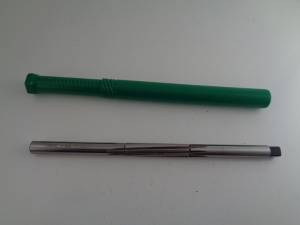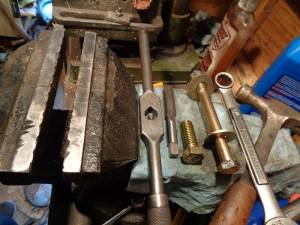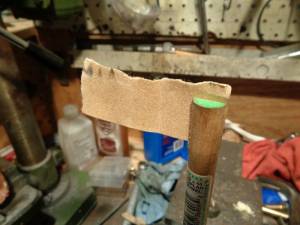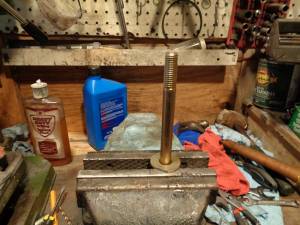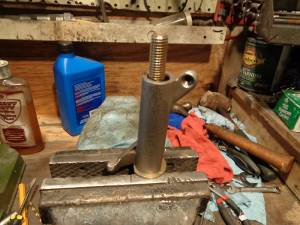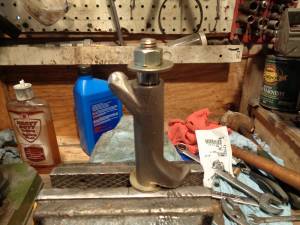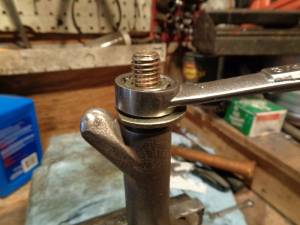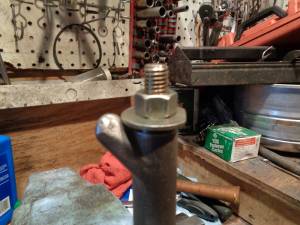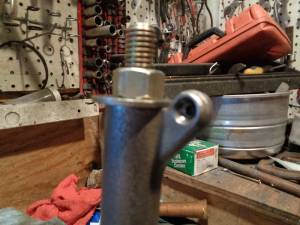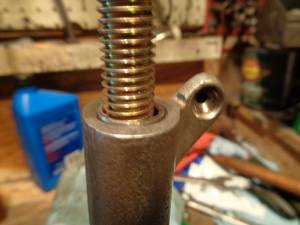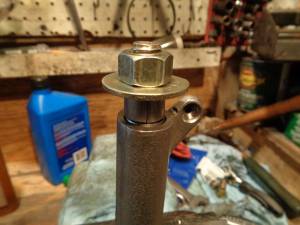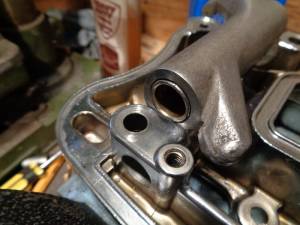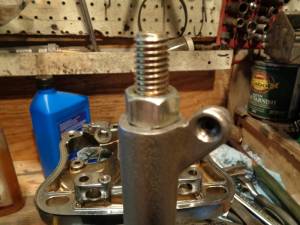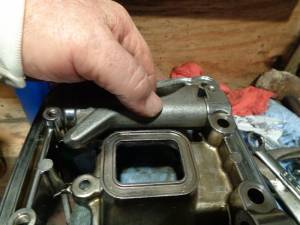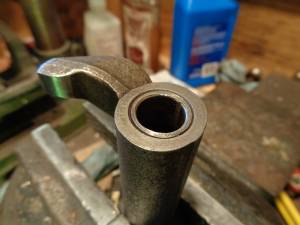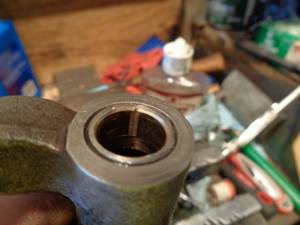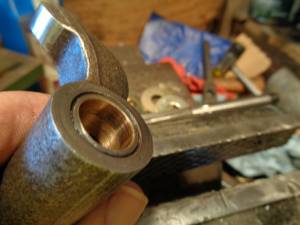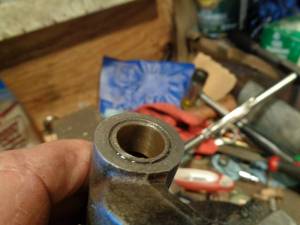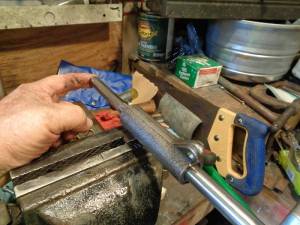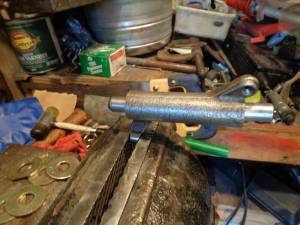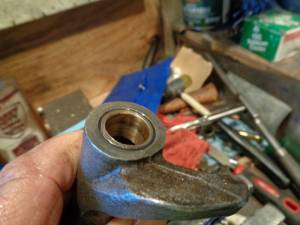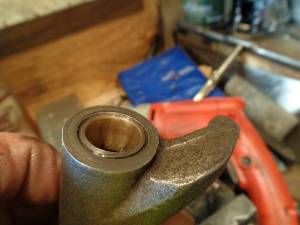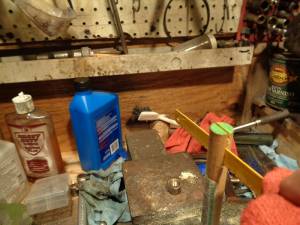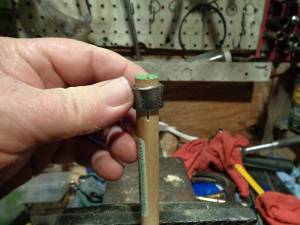Table of Contents
This is an old revision of the document!
REF: Service Procedures 17
Replacing Rocker Arm Bushings
This procedure is ONLY needed IF you want to replace the bushings but not the rocker arms.
New rocker arms come with new bushings that have already been properly sized for the rocker arm shafts.
A helpful suggestion is to mic the bushings closely and several times to be sure you need to before replacing them. 1)
If the rocker arm pads or the pushrod cups are worn badly, it'd probably be best to just replace the arms instead.
New rocker arms come with the bushings installed and pre-sized.
Specs: Shaft in bushing (loose)
New install: .0005” - .0020“ (.013 mm - .051 mm)
Service Limit: .0035” (.089 mm)
It's not common to have to replace the rocker arm bushings. 2)
Unless you run them dry or put high lift cams in causing them to hit the boxes, you shouldn't have an issue with them.
The bushings may wear eventually, but that should be well in to the 100k territory.
As far as rocker arm bushings, where they're made isn't nearly as important as having them installed and fitted correctly. 3)
Replace the rocker arm bushings one at a time.
Bushings
- Superior Dixie Distributing makes a set of 4 bushings (17428-57).
Tools
For bushing removal
Basically, you'll need to tap 9/16“ threads in the bushings so you can thread a bolt in there and knock the bolt out with a punch, carrying the bushing with it.
As an alternative, you can use a longer bolt and use a press to push the bolt/bushing out.
It's a good idea to use a bolt to hit / press against instead of the tap since the tap can break then you'll have to thread a bolt in anyway.
Then you'll have wasted a tap and possibly destroyed the threads you just cut.
- Basic tool list:
- (1) 9/16”x18 tapered thread tap
- (1) 9/16“x18x1” grade 8 bolt (3/4“ to 1-1/2” length will work)
- (1) tap wrench to fit the 9/16“ tap
- (1) drift or punch
- (1) Hammer
For bushing installation
You can use a long 1/2” bolt / nuts and washers as a press to pull the new bushings into the rocker arm.
Or you can an arbor press or shop press to pull them in also.
- Nut / Bolt Press:
- (1) 1/2“x13x5” grade 8 bolt
- (2) 1/2“ grade 8 washers
- (1) 1/2” grade 8 nut
- (1) 3/4“ box end wrench
- Arbor Press or Shop Press:
- You can make an arbor button that will fit the bushing with a stop shoulder, could be any length. 4)
That way, the ID is protected from the threads and with the stepped shoulder, press it home until it stops.
The arbor button could be a right sized bolt with a long shank with the threads cut off. This would negate the need for turning one on a lathe.
- Using a Bench Vise:
- A standard bench vise isn't the best idea, but if your vise opens wide enough, you could try it as a press with an arbor button as mentioned above. 5)
- However, keep in mind that most bench vises do not have a dedicated flush pull though. 6)
The jaws will pull closer together on the opposite side of where the piece is clamped.
So the rocker arm would need to be placed in the center of the vise to help ensure a center pull on the bushing to keep it from binding / distorting.
Then pull the bushing in slowly checking for binding as you go. It will get tight once the bushing gets about halfway home.
For bushing reaming / sizing
- Using the JIMS rocker arm bushing reamer:
- JIMS reamer (94804-57) is quite expensive at a current average of $267. But it works very well.
It is used with a hand tap wrench or socket wrench.
Note: This reamer has left hand spiral blades (right hand cut). Always turn it to the right (clockwise) when installing, reaming or removing it from the bushings.
Never turn it to the left while in use.
- Using a Chucking reamer:
These are less expensive but there are considerations for using one.
This is a non tapered reamer with a small chamfer on the end and is shorter than a tapered reamer.- This type reamer is best used in a milling machine.
- It can be used to hand ream but only if you have a centering fixture like a sleeve bushing inserted in the opposite end of the rocker arm.
The hole has to be centered from one bushing thru to the end of the opposite bushing. - It can be used with a hand drill on low speed. Non tapered reamers cut on the chamfered end and center around the cut they just made.
If it bites more to one side or the other, especially on the initial cut, the rest of the ream job won't go well.
A extra sleeve bushing for the reamer shaft is a must for using this type reamer for these bushings.
- Line Lapping (if necessary):
- (1) 1/2”x12“ wooden dowel
- A few small pieces of sandpaper:
- 60 grit, 220 grit, 400 grit, 1500 would be good to have on hand depending on how the reaming goes.
Procedure
Remove the existing bushing
- Press or drive one bushing out of the rocker arm while leaving the other in place.
- The 9/16”x18 tap is used to cut threads into the bushing to give you something to bite into it and knock or press it out from inside out.
- Stand the rocker arm into a bench vise while just snugging the vise around the arm.
- The vise won't hurt the hardened rocker arm.
- Spread some tapping oil on the 9/16“x18 tap.
- Thread the tap into the bushing.
- The taper will allow you to center up the tap as best as possible before cutting the threads in the bushing.
- The bushing will be 'out of round' by default of needing to be replaced.
- Likewise, the threads you'll be cutting into the bushing will not be perfect.
- As long as the bushing will take threads, this will work.
- While tapping the bushing, hold slight pressure downward (or inward) to keep the tap from sitting and spinning.
- If it spins without continued cutting, it will remove the threads it just cut.
(if this happens too far into the bushing, the new threads will be useless in removing the bushing) - Thread the tap in far enough to cut threads on the full length of the bushing.
- The tap won't be long enough to affect the existing bushing in the other end.
- Remove the tap, clean the new bushing threads and install the 9/16”x18 bolt for the length of the bushing.
- The bolt is used in place of the tap to keep from damaging the tap while knocking the bushing out.
(the bushing can also be pressed out using a drift on the bolt as well)
- Then, from the opposite end, press or knock the bushing out of the rocker arm using a drift or punch.
- The rocker's arm can be set on a wooden corner with the shaft bore hanging off the edge.
- Then place the drift into the opposite end and hit downward with a hammer.
- It takes a couple good strikes to knock the bushing out about halfway.
- Then you can hold the assembly in one hand and gently finish tapping the bushing out.
| Thread the lubed tap into the bushing. 10) | ||
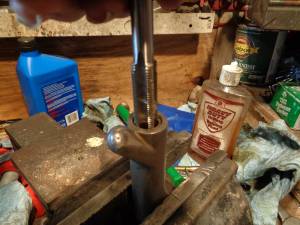 | 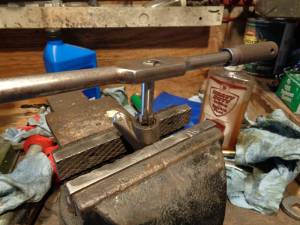 | 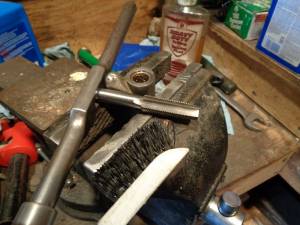 |
| Clean the threads in the bushing for the 9/16“ bolt. The vise won't hurt the rocker arm. 11) | ||
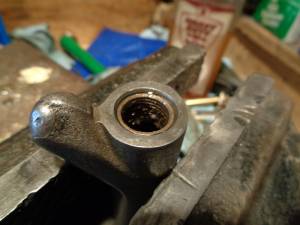 | 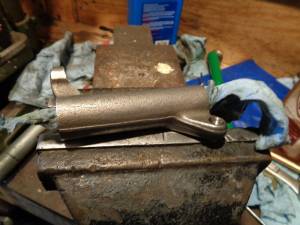 | 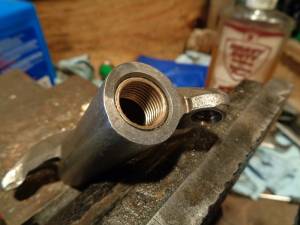 |
| Run the 9/16” bolt in for the length of the bushing. It takes a couple good hits to initially move the bushing. 12) | ||
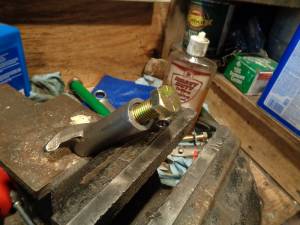 | 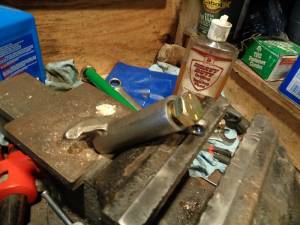 | 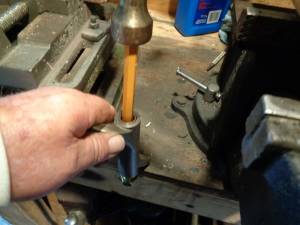 |
| Once the bushing pops out about halfway, you can use softer blows to finish removing the bushing (and not drop and ruin the bolt threads). 13) | ||
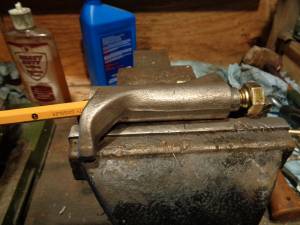 | 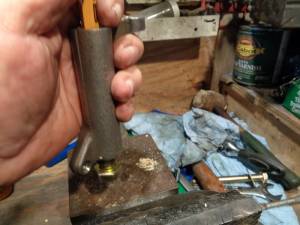 | 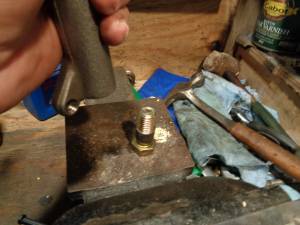 |
| The newly cut threads will be damaged once the bushing is removed. This makes the initial threading important for best results. 14) | ||
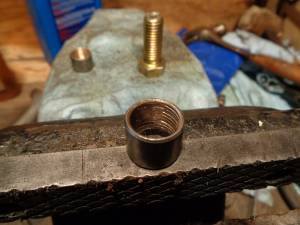 | 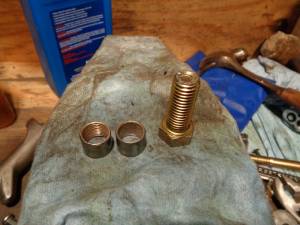 | 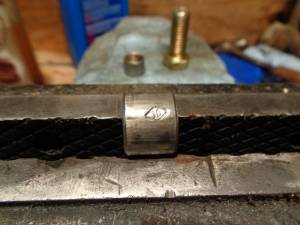 |
Install the New Bushing
- Press the replacement bushing into the rocker arm flush with the arm end.
- Place the split portion of the bushing towards the top of the arm.
- The 1/2“x13x5” bolt was used below to pull the new bushing into the rocker arm bore.
| Clean the bore of all oil and debris. Actetone or brake cleaner works well. 15) | |
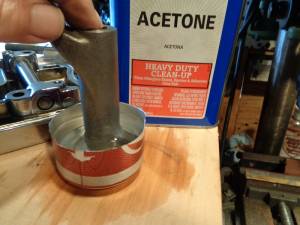 | 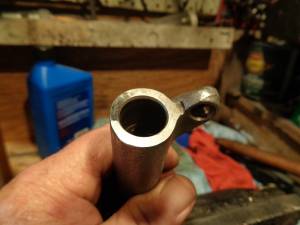 |
| Standard 1/2“ washers were cut down on one side to clear the rising edges of the arms to get a flat pull on the bushing. Then the bolt hex was stood up into a bench vise. 16) |
||
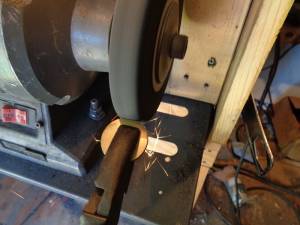 | 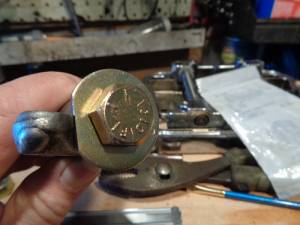 | 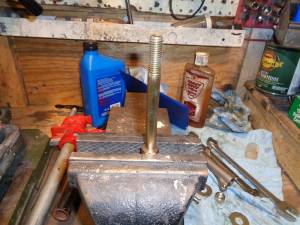 |
| If needed, the end of the bushing can be filed down flush to the rocker arm. Place a straightedge across the assembly to ensure it's flat end to end. The file will cut down the bushing before harming the hardened rocker arm. 17) |
||
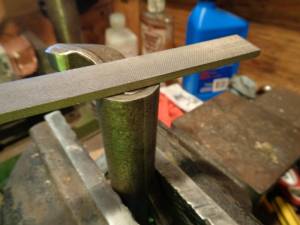 | 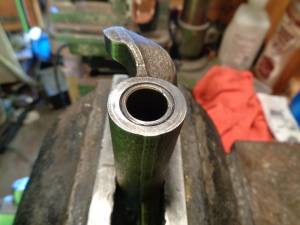 | 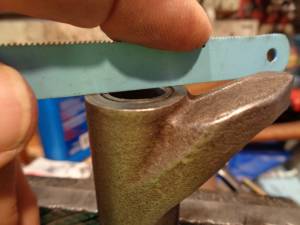 |
Ream the New Bushing to Size
The proper way to ream rocker shaft bushing's is to come in from the opposite bushing with the reamer. 18)
That way the existing bushing acts as a guide for the bushing being reamed.
Factors for a good reaming job include; 19) 20)
- Alignment: The bushing needs to be in perfect alignment when pulled into the rocker arm.
You'll also be using a wider bore (existing used bushing)than the reamer as a base line.
Choose the best bushing of the two to replace last.
The reason for line boring is to get a straight line thru for the shaft.
What is bad about a reamer and going free hand is bell mouth. 21) Slight wiggles can create a wider opening on the outside of the bushing.
Using the existing bushing thru to the new one 'helps' to keep the reamer centered in the rocker arm. - Size: You have little, if any, control over the finished size the reamer gives while doing this at home.
You basically get what the reamer gives. Finished over size or under size is not a good thing.
Sizing needs to be done to fit each rocker shaft to it's corresponding bushing. I.E. A to A, B to B, etc. along with trial fitting with zero burrs or high spots on the shafts. 22) - Position: Each bushing should be installed straight, not cocked or collapsed. 23)
If the new bushing installs at a slight angle, this will throw the position of the reamer off.
Then the reamer will have to cut at the same time it's fighting a non straight path toward the end of the bushing.
The bushing will shrink when it is squeezed into the arm bore.
The slit in the bushing may also distort to an 'out of round' condition when installed creating a bumping condition while reaming. - Surface finish. Again you have little, if any, control over this at home. You basically get what the reamer gives. Too course isn't good for bushing life.
- Machining conventions. This is the method for replacing the bushings in the rocker arm as explained in the FSM.
The process is slow, not to mention the variances in accuracy.
Chances are the MoCo used dedicated machinery to handle this task.
This method is an answer to a field tech or home mechanic needing to change the bushings.
Chances are the results will not be as good as the factory machining hence the wide spec range for a new installed bushing job.
The process;
- Line ream the bushing using rocker arm bushing reamer (94804-57).
- “Jims” also makes this tool. You can find it online.
- Use the remaining old bushing as a pilot hole (to keep center).
Reaming
| Keep plenty of cutting oil or lube on the reamer. 24) |
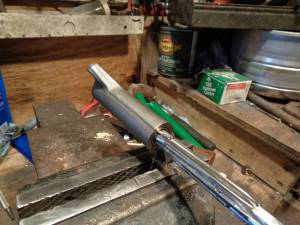 |
| A 12 mm socket and wrench can be used to turn the reamer. But a standard tap wrench works good. You can see how much was cut out during reaming. 25) | ||
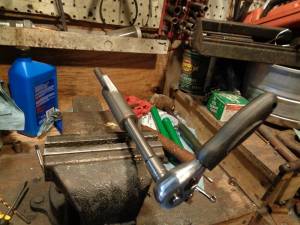 | 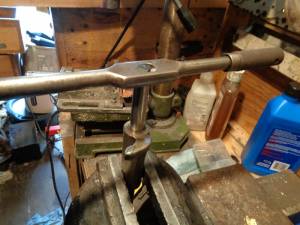 | 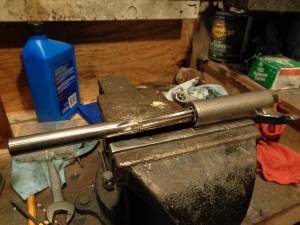 |
| The reamer was sent back through with resistance noticed. But no more shavings ended up on the reamer. So the reamer is done cutting even though the shaft will not slide into the bushing and probably from one or more conditions above. The reamer theoretically cuts a center hole thru / from both bushings. However, the hole now has to be lapped to widen the 'centered' hole to accept the shaft. (in proper clearance) 26) |
||
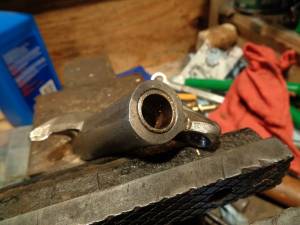 | 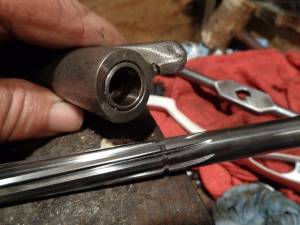 | 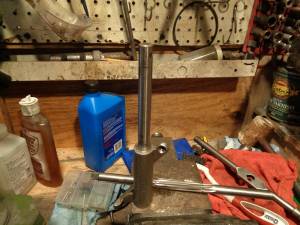 |
| The reamer was lightly ran back through. | This revealed a dark ring where the reamer was binding but not cutting. | |
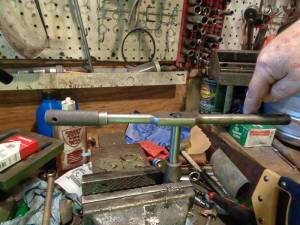 | 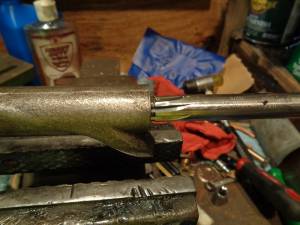 | 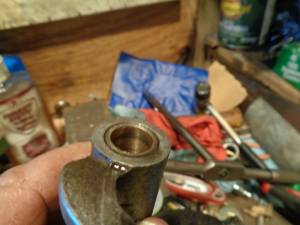 |
Lap New Bushing If Needed
Sometimes a reaming job just doesn't quite go as expected or doesn't quite give the clearance needed.
If using a same size reamer as the shaft, you can ream the bushing and then lap it to get the desired clearance.
This will yield a tighter clearance than using the next up size reamer.
Lapping is a common practice after reaming.
A lapping tool can be made from a 1/2“ wooden dowel and a small piece of sandpaper. 27)
Make the dowel long enough to run the full length of the rocker arm plus enough to get a hand on to turn it (12” or so).
Use a hacksaw blade cut a slot down the middle of one end to hold the sandpaper.
Make the slot longer than the bushing so you can be sure to have contact on the full length of the bushing.
Initially cut a piece of sandpaper to go one full revolution around the dowel. 28)
Too many wraps will not slide into the bushing as it will then be too thick.
You can add more if needed but be sure and measure the bore periodically so it doesn't get out of clearance.
You just need to turn or lap the bushing slowly and evenly.
This will also smooth out the bushing surface for a less restriction on the shaft.
Grit of sandpaper will be determined by the condition of the bore and clearance desired.
Insert the bare end of the dowel into the bushing to lap and exit the dowel out the non lapped bushing.
This will allow you to basically line lap the intended bushing to help keep center between the two.
| 60 grit was used first for a couple rounds followed by 220 grit paper (re-measuring before each new piece was used).29) | ||
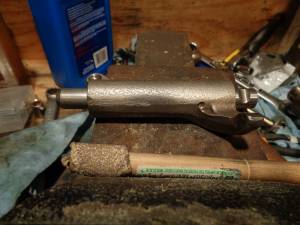 | 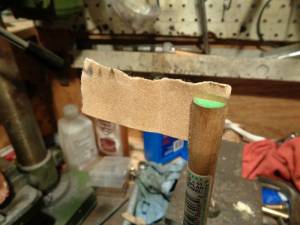 | 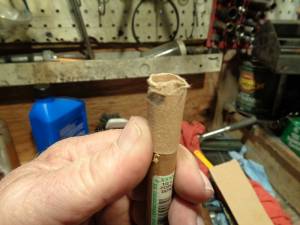 |
| Line lap, measure and check shaft fit and movability. Each time you remove the lapping tool, spin it out while pushing on it. This will help keep from creating an axial scratch in the bushing. 30) |
||
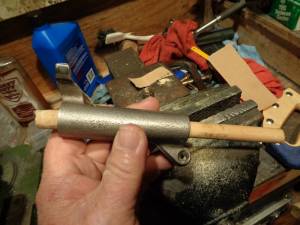 | 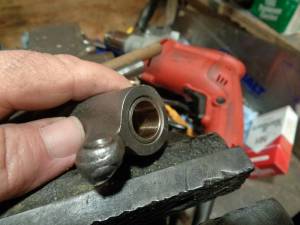 | 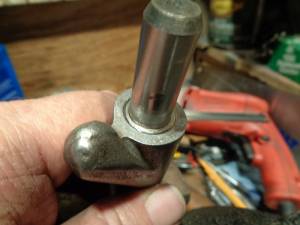 |
Repeat until the clearance is correct at each bushing / shaft end (individually measured and matched per side).
| A drill with fine sandpaper can also condition for a slick surface. Test fit with the assembly in the rocker. 31) | |
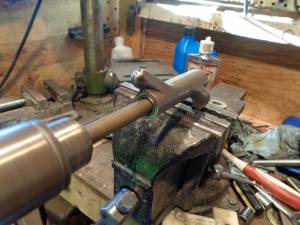 | 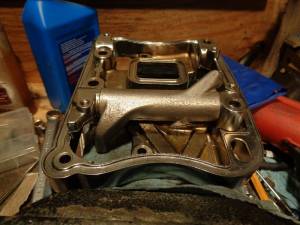 |
Repeat for the other bushing(s)
- Once you've got the new bushing reamed and lapped, repeat the procedure for the bushing on the other end.
- This time, you'll use the new (sized) bushing as a pilot hole to ream the second bushing.

